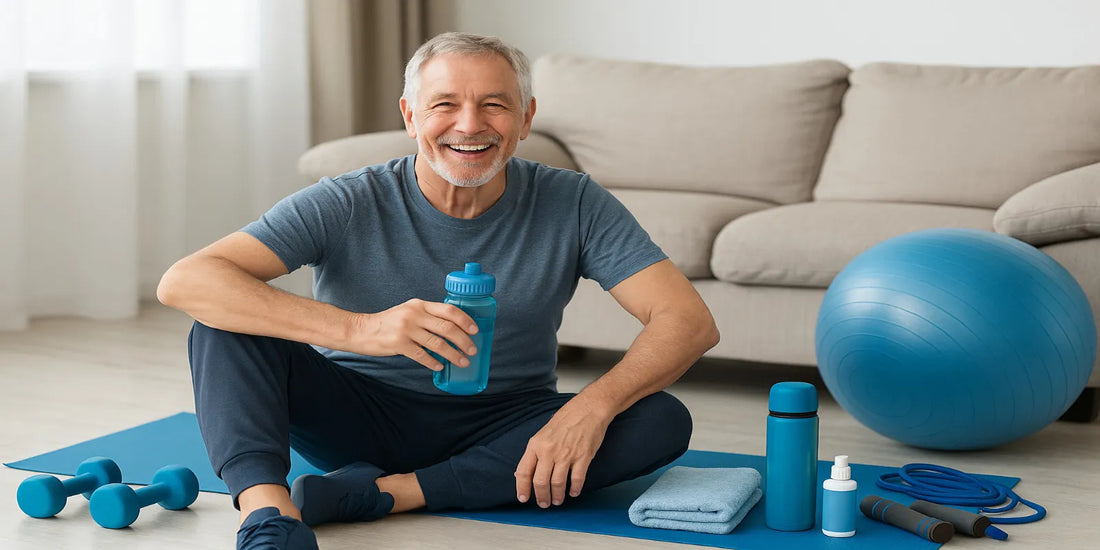
Senior Fitness Essentials 2025 – 9 Safe Routines Over 50
Share

Senior Fitness Essentials – 9 Safe Routines Over 50
Staying active after 50 is possible and rewarding. Safety and enjoyment come first. Small, steady sessions protect joints and build confidence. This guide explains low-impact tools, easy routines, and clear cues to stop before discomfort. You do not need a full gym. A mat, a band, and light weights are enough to begin.
Why move now? Regular activity helps the heart, muscles, and mood. The WHO links moderate exercise to lower chronic disease risk. The CDC notes balance and strength work reduce falls. Research shared by the NIH shows consistent training improves daily function. These findings support short, low-impact sessions as a safe start.
Senior Fitness Essentials 2025: Start Smart and Low-Impact
Begin with a simple warm-up. March in place for one minute. Roll shoulders. Breathe slowly. Next, try a gentle circuit: sit-to-stand from a chair, wall push-ups, and band rows. Keep each set to 8–10 smooth reps. Rest for 45–60 seconds. If breathing feels hard, pause. Use a stable chair and non-slip mat. Pain is a stop sign, not a goal.
For cardio, choose options that are kind to knees and hips. A brisk walk, an indoor cycle at low resistance, or a short step-touch routine works well. Aim for 10 minutes at first. Add two minutes each week. Finish with calf, hamstring, and chest stretches. Hold each for 20 seconds. Move within a comfortable range only.
Senior Fitness Essentials 2025: Building Strength Safely
Strength training helps maintain independence. Light weights or resistance bands can preserve lean muscle. Studies from the National Library of Medicine show strength work prevents age-related muscle loss. Begin with one to two sessions per week. Each session should target large muscle groups: legs, chest, and back. Keep movements slow and steady. Avoid jerky motions. Focus on form, not load.
Safe beginner moves include chair squats, wall push-ups, and bicep curls with one to two kilograms. Rest for one minute between sets. Perform eight to twelve repetitions. Use controlled breathing: exhale on exertion, inhale on return. Stop if any sharp pain occurs. Consistency is key. Progress by adding light resistance, not sudden heavy loads.
Senior Fitness Essentials 2025: Balance and Flexibility
Balance reduces the risk of falls, which is critical for seniors. The Journal of Aging Research reports tai chi and balance drills improve stability. Simple daily routines such as standing on one foot near a wall or heel-to-toe walks are effective. Aim for two to three minutes per drill. Repeat twice daily. Keep a sturdy support close.
Flexibility keeps joints mobile and reduces stiffness. Stretch after every workout. Include shoulder rolls, neck stretches, and calf stretches. Hold each for 15–20 seconds. Never bounce during stretches. Breathe calmly. A yoga mat adds comfort and safety. Over time, improved flexibility supports smoother, easier daily movement.
Senior Fitness Essentials 2025: Healthy Routines for Longevity
A complete routine blends cardio, strength, balance, and flexibility. Each element works together for long-term wellness. Research from the Harvard Health team highlights exercise as a key anti-aging tool. Weekly goals include 150 minutes of moderate activity, two strength days, and daily flexibility practice. Split sessions into short blocks to avoid fatigue.
Lifestyle also matters. Drink water before and after workouts. Choose shoes with strong grip. Keep rooms well lit when exercising at home. Partner workouts boost motivation and accountability. Track progress with a simple journal. Celebrate small wins. Safe routines build a foundation for active, healthy aging well beyond 2025.
